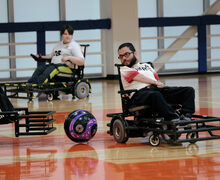Smith: Gadgets aim to trim the fat from tech-driven lifestyles, tackle global obesity issues
Every new era of technological change brings its own issues to the table, and as we continue to feed on a steady diet of information, our waistlines are expanding just as fast as our bandwidth.
A cross-cultural study by the Milken Institute found that for every 10-percent increase in information communications technology investment, there is a 1.4-percent total increase in obesity rates.
A similar study by McCann Erickson found that of 7,000 participants from across the globe, 46 percent think technology is making them sicker and 20 percent believe technology is making them fat.
So, how do we use technology to treat the problem it essentially created?
Segway inventor Dean Kamen believes the solution could be to suck the food right out of your stomach with his latest creation, AspireAssist. The product user would insert a tube into a port in his or her skin, which passes through the abdomen and into the stomach. After eating, he or she would attach a bag to the port and drain the top one-third of the food before it has the opportunity to be digested.
I’m a little skeptical about this product, considering it’s only been tested on 50 people and Kamen’s business partner, AspireAssist CEO Katherine Crothall, has acknowledged “that this concept sounds grotesque at first.” Uh yeah, pretty much.
The team insists that it’s “for morbidly obese people who want to lose weight, and it’s a very viable alternative to conventional bariatric surgery.”
Thankfully, the future of technology is not all doom, gloom and fatty foods. The Milken study also found that a one-percent increase in the number of physically active people can prevent a 0.2-percent rise in obesity, which suggests we can mitigate the effects of obesity by encouraging healthy habits.
For the tech-savvy consumer, this means getting your digital diet started with a fitness application or meal tracker. With 13,000 apps available on the market and about 500 more in development, there’s certainly no shortage of choices.
But a recent study by the Pew Research Center shows the majority of consumers are still tracking their diet in their head or writing it down on paper. Only 21 percent said they used technology to help monitor their health.
I’d be willing to bet that the 21 percent who are using the app as an aid, and the online support group that comes with it, are seeing better results than those relying solely on mental notes and good intentions.
I switched to the digital diet lifestyle this summer by using one of the most popular apps, MyFitnessPal, and was faced with the horrifying graph of my weekly calorie intake, which hit telling highs on the weekends when late-night binges are inevitable. It worked well for a while, until I slipped back down the slippery, greasy slope that is Acropolis pizza and into delicious denial.
But the best solutions are often the simplest ones, which is why my favorite fat-fighting gadget is the HAPIfork. The HAPIfork is billed as a “hi-tech” fork that monitors how quickly you’re eating and vibrates to tell you to slow down.
Although some, like television personality Stephen Colbert, have mocked the device, I think it’s just silly enough to work. Yes, it’s solving a first-world problem, but with nearly 4.2 million newly obese people in the United States, maybe we all need a little jolt to tell us when to put down the fork.
Kat Smith is a senior creative advertising major. Her column appears weekly. She can be reached at [email protected] or by telepathy, if possible.
Published on January 31, 2013 at 2:30 am




